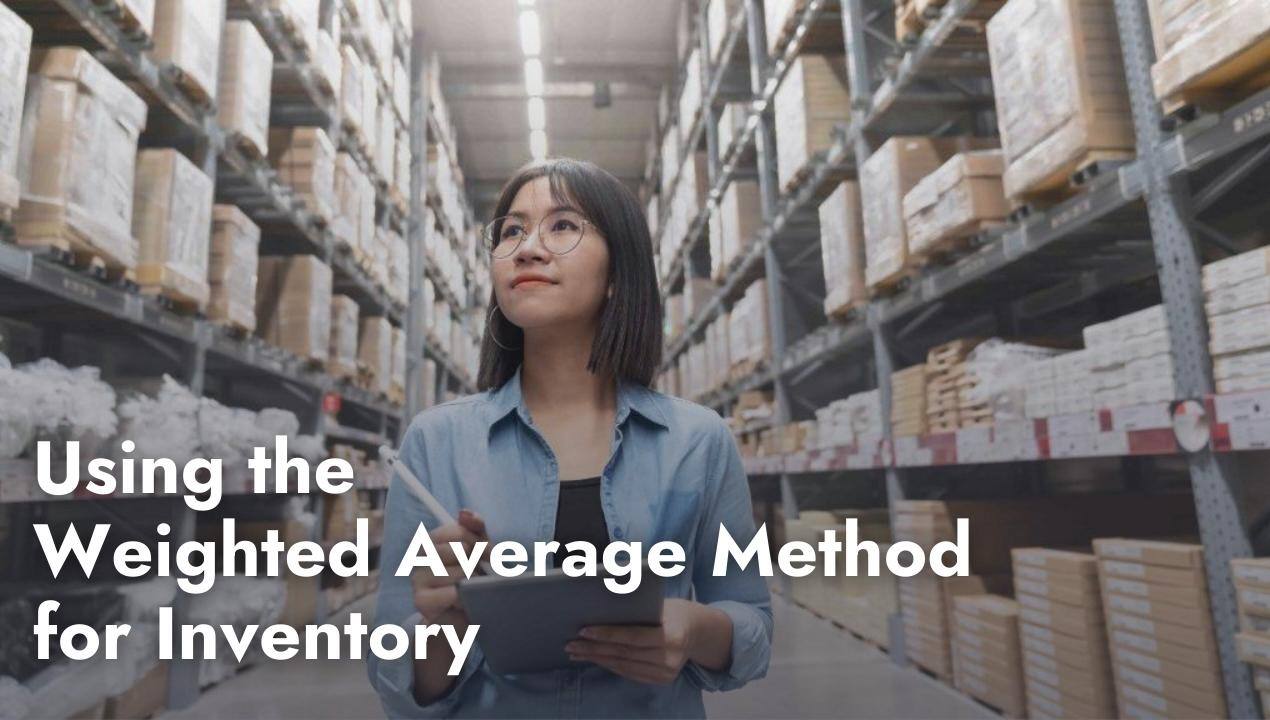Share this
Using the Weighted Average Method for Inventory
by Rin Mosher on Mar. 8, 2024

Proper inventory management is critical for ecommerce fulfillment, involving significant time and resources to ensure accurate accounting and efficient processing. Streamlining it through accurate tracking is essential — but valuing your inventory accurately is equally crucial. The weighted average method, a popular inventory valuation approach, helps businesses selling similar products in bulk to assess their inventory's monetary value effectively.
As a valuation method, understanding inventory costs through Weighted Average Cost (WAC) can inform better stock management strategies, aiding in the broader goal of efficient inventory management. In this blog, we will dive into what weighted average cost is, how to calculate weighted average cost, and discuss when it makes the most sense to use WAC over other inventory valuation techniques to keep your fulfillment running smoothly.
What Is the Weighted Average Method?
The Weighted Average Cost (WAC) is a Generally Accepted Accounting Principles (GAAP) and International Financial Reporting Standards (IFRS)-recognized accounting method. The weighted average cost formula calculates the average cost per unit of inventory by considering the total cost of goods available for sale and the total number of units available. This average cost is then used to determine an ecommerce business’s Cost of Goods Sold (COGS) and ending inventory value.
Staying on top of the WAC of your stock will ensure you don’t over or underestimate your inventory needs, and likewise makes it easier to come to data-driven pricing decisions that accurately reflect your business’ spending.
For instance, knowing average cost per unit can make it easier to decide how much of a discount to offer on specific products without incurring a loss. This knowledge can help make more informed decisions regarding which products to restock, which to order in larger quantities, and which might be discontinued based on their profitability and sales performance.
WAC further enables businesses to maintain consistent profit margins across their product lines and avoid the fluctuations that might occur if they based prices on the cost of the last batch of products they purchased. This is incredibly valuable to operating sustainably during times of market fluctuations.
It's also important to have this number ready for financial reporting and tax purposes, since you'll use weighted average to determine net and taxable income at the end of the fiscal year.
How to Find Weighted Average Cost for Inventory
Weighted Average Cost Inventory Formula
The WAC is calculated by multiplying the unit cost of each item in inventory by its respective quantity and then dividing the total cost by the total number of units. This provides a weighted average that takes into account not only the price but also the quantity of each item in stock.
The weighted average cost formula is as follows:
WAC = Cost of goods available for sale / Total number of units in inventory
Calculating the weighted average cost per units starts with determining the cost of goods for the inventory your business currently has available for sale. You'll then need to define the total number of units in your business’ real-time inventory.
Finding the Cost of Goods Available for Sale
To calculate the cost of goods available for sale, add the total value of current inventory to the cost of producing that inventory. The resulting number will be the first part of the input you need to calculate weighted average cost.
Here’s what this looks like when expressed as a formula:
Cost of goods available for sale = Total inventory value + Cost of producing inventory
Finding the Total Number of Units In Inventory
Total number of units available for sale is important in calculating WAC, as it determines the proportion of each inventory item's cost. You can determine this number by adding your beginning inventory in units to purchases in units.
Weighted Average Cost Example
Let's say your beginning inventory value is $10,000 and you made additional purchases of $5,000 during the accounting period. 500 products will be reported as inventory.
WAC = ($10,000 + $5,000) / 500
= $15,000 / 500
= $30 per unit
This means that the weighted average cost of each unit in inventory is $30.
When the Weighted Average Method Works Best
The weighted average method is one of several you can use to manage your ecommerce business' inventory levels. Here are some factors that might make this inventory valuation method better for your ecommerce business than the alternatives we’ll discuss later on.
Keeping Track of Inventory with Fast Turnover
WAC only requires a single cost calculation and is therefore convenient in cases where inventory flows in and out the door quickly. It allows for easy updates to the weighted average cost per unit, keeping purchasing decisions informed every reporting period. If your ecommerce business has a fast inventory turnover ratio (ITR), it will benefit from this ability to grasp quick insights without the expense of accuracy.
If you’re looking for an all-in-one tool that compares the options we’re reviewing in this article, download our inventory management calculator. It can run numbers for WAC, FIFO, and LIFO to provide you with case specific insights on which method will work best, as well as help uncover key inventory ratio and reorder point data.
Selling Products That Are Similar Enough to Put Into Groups
Tracking individual costs for each item in an inventory can be time-consuming and complicated, especially if you sell a variety of similar products. Using the weighted average cost method to group these items simplifies the process, saving time and effort. However, for businesses with distinct and easily identifiable products, the specific identification method could be more appropriate, as it's best suited for unique or high-cost items. We’ll discuss this method and other potential alternatives in the next section.
Dealing with Stable Purchase Prices
The Weighted Average Cost method effectively averages out the cost of inventory over time, which can be advantageous for smoothing out fluctuations in purchase prices. This averaging approach means that each purchase price is taken into account equally, leading to a more stable cost per unit across reporting periods.
However, it's important to note that because the WAC method blends these costs, it might not be the best choice for businesses looking to closely track and respond to specific price fluctuations in real-time. For those scenarios, a method that allows for the immediate recognition of cost changes, such as FIFO (First In, First Out) or LIFO (Last In, First Out), might be more appropriate. These alternatives can provide a clearer view of how recent price changes impact inventory valuation and cost of goods sold.
Weighted Average Method Alternatives
Weighted average cost is one of four fundamental inventory valuation techniques in fulfillment. Multiple methods exist to cater to individual business needs, and each method has its own pros and cons. In this section, we will explore some alternative methods to weighted average cost along with their advantages and disadvantages.
First-In-First-Out (FIFO)
The First-In-First-Out (FIFO) method works in a way that ensures old inventory units are sold before new ones. This is usually standard protocol when handling products with expiration dates like skincare and cosmetics, health supplements, or consumer packaged goods.
The challenge of executing the FIFO method is complexity. Weighted Average Cost only requires you to know how many units you have, whereas FIFO is informed by both unit quantity and inventory age. More lot tracking is involved, which can become time-consuming.
It's also worth recognizing that the cost of older inventory units purchased may not accurately reflect current market value, as the FIFO method assumes everything is priced the same. This can affect the accuracy of inventory costs and may lead to distorted profit margins if costs fluctuate over time.
You should use FIFO when you:
- Need to mitigate product expiration
- Want to minimize waste
- Require a consistently accurate cost of goods sold
You shouldn’t use FIFO when you:
- Have insufficient resources for manual tracking
- Can’t take on more complex and time-consuming processes
- Have difficulty managing different batches of products
Last-In-First-Out (LIFO)
Last-In-First-Out (LIFO) is essentially the opposite of FIFO, calling for a warehouse's newest inventory units to be sold first. The model aims to better reflect current market prices by matching the more recent costs with incoming revenue. It makes sense in times of inflation, as it allows businesses to report lower profits and pay less taxes.
However, LIFO can also lead to an incorrect valuation of inventory and create a mismatch between reported profits and actual cash flow. LIFO is prohibited under IFRS rules because it has the potential to be abused for lower tax rates by understating a company's earnings. This does not apply to FIFO, which is accepted by both the IFRS and GAAP principles.
LIFO requires precise tracking and organization, as well as timely updates on inventory levels and costs. While both FIFO and LIFO methods necessitate diligent inventory management, the choice between these two methods often depends more on financial strategy and inventory cost management than on managing product shelf life.
You should use LIFO when you:
- Want to save money on taxes during times of inflation
- Need to accurately reflect current market prices
- Operate in an industry with high turnover rates
You shouldn’t use LIFO when you:
- Are concerned about potentially misrepresenting inventory value and profits
- Don’t have the resources to precisely track and organize units
- Want to avoid higher taxes in times of deflation
Specific Identification
The specific identification method is a lesser-known approach to inventory valuation that is used primarily for high-value, unique items. It involves keeping individual records of each inventory item and tracking their cost and sale price.
This method offers the most accurate reflection of inventory costs, as it takes into account the specific unit cost for each product. This can be especially beneficial for businesses that sell one-of-a-kind or highly customized products.
However, using the specific identification method can be a significant logistical challenge for businesses with large inventory volumes. It requires meticulous record-keeping and tracking of each individual item, which can be time-consuming and expensive.
You should use specific identification when you:
- Need precise insight into cost of goods sold
- Must ensure unique items are accurately valued
- Are in search of better decision-making and pricing strategies
You shouldn’t use specific identification when:
- Short on time and resources
- Handling large inventory volumes
- Unable to take on the higher overhead costs that come with record-keeping and tracking
The Final Verdict: Is Weighted Average Cost Right for You?
The average weighted cost method is beneficial for businesses because it provides a more accurate representation of the true cost of inventory. It takes into account both older and newer inventory purchases for a more balanced cost per unit. Being easy to calculate, WAC delivers the most value in cases where products come and go quickly, and prices are unpredictable.
It isn't the only option, though. Inventory management is not one-size-fits-all, and what works for one company may not work for another. It's important to weigh the advantages and disadvantages of the weighted average cost method against other methods, such as FIFO and LIFO, to find a solution that makes sense for your individual business and products.
Shipfusion's third-party logistics (3PL) services offer a simplified solution for businesses looking to delegate their inventory management. Our warehouse teams take on the daunting task of tracking expiration, arrival, and departure dates while ensuring every product you send customers is the right one. Learn more about our inventory management software and services, along with everything else that makes us the best 3PL around, by continuing your journey with us today.
Share this
You May Also Like
These Related Articles

What Is A Perpetual Inventory System For Ecommerce?

Inventory Insurance: Why It Matters for Your Business

How to Calculate the Inventory Turnover Ratio for Ecommerce
- April 2025 (18)
- March 2025 (26)
- February 2025 (26)
- January 2025 (37)
- December 2024 (16)
- November 2024 (23)
- October 2024 (22)
- September 2024 (27)
- August 2024 (9)
- July 2024 (8)
- June 2024 (5)
- May 2024 (8)
- April 2024 (8)
- March 2024 (6)
- February 2024 (6)
- January 2024 (5)
- December 2023 (3)
- November 2023 (3)
- October 2023 (5)
- September 2023 (4)
- August 2023 (2)
- July 2023 (1)
- June 2023 (4)
- March 2023 (2)
- October 2022 (1)
- September 2022 (5)
- August 2022 (4)
- July 2022 (7)
- June 2022 (4)
- May 2022 (4)
- April 2022 (6)
- March 2022 (2)
- February 2022 (1)
- January 2022 (3)
- December 2021 (2)
- November 2021 (4)
- October 2021 (2)
- September 2021 (5)
- August 2021 (4)
- July 2021 (4)
- June 2021 (3)
- May 2021 (2)
- April 2021 (3)
- March 2021 (3)
- February 2021 (3)
- January 2021 (2)
- December 2020 (4)
- November 2020 (2)
- October 2020 (4)
- September 2020 (2)
- July 2020 (5)
- June 2020 (4)
- May 2020 (2)
- April 2020 (2)
- March 2020 (4)
- February 2020 (1)
- December 2019 (1)
- May 2018 (1)
- March 2018 (2)
- February 2018 (3)
- January 2018 (3)
- November 2017 (3)
- July 2017 (4)
- March 2017 (3)
- February 2017 (5)
- January 2017 (3)
- December 2016 (4)
- November 2016 (6)
- October 2016 (6)
- October 2015 (1)
- September 2015 (1)
- June 2015 (3)
- May 2015 (3)
- August 2014 (1)
- July 2014 (1)
- March 2014 (1)
- February 2014 (1)